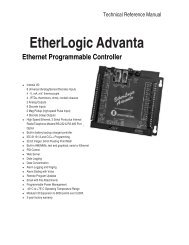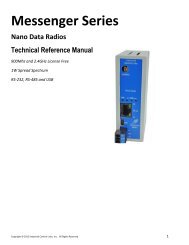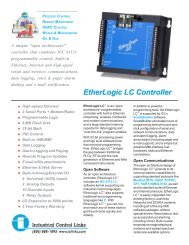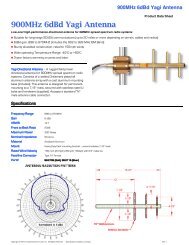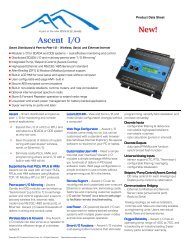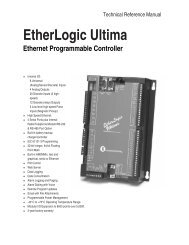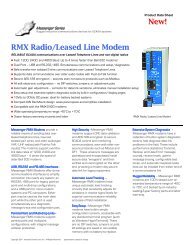9XTend-PKG-R™ RS-232/485 RF Modem
9XTend-PKG-R™ RS-232/485 RF Modem
9XTend-PKG-R™ RS-232/485 RF Modem
- No tags were found...
Create successful ePaper yourself
Turn your PDF publications into a flip-book with our unique Google optimized e-Paper software.
<strong>9XTend</strong>‐<strong>PKG</strong>‐R <strong>RS</strong>‐<strong>232</strong>/<strong>485</strong> <strong>RF</strong> <strong>Modem</strong> – Product Manual v1.2.4Binary Command ModeSending and receiving parameter values using binary commands is the fastest way to change theoperating parameters of the XTend <strong>RF</strong> <strong>Modem</strong>. Binary commands are used most often to samplesignal strength (DB parameter) and/or error counts; or change modem addresses and channelsfor polling data systems. Since the sending and receiving of parameter values takes placethrough the same serial data path as 'live' data (received <strong>RF</strong> payload), interference between thetwo data types can be a concern.Common questions about using binary commands:• What are the implications of asserting CMD while live data is being sent or received?• After sending serial data, is there a minimum time delay before CMD can be asserted?• Is a delay required after CMD is de-asserted before payload data can be sent?• How does one discern between live data and data received in response to a command?The CMD pin must be asserted in order to send binary commands to the <strong>RF</strong> modem. The CMD pincan be asserted to recognize binary commands anytime during the transmission or reception ofdata. The status of the CMD signal is only checked at the end of the stop bit as the byte is shiftedinto the serial port. The application does not allow control over when data is received, except bywaiting for dead time between bursts of communication.If the command is sent in the middle of a stream of payload data to be transmitted, thecommand will essentially be executed in the order it is received. If the radio is continuouslyreceiving data, the radio will wait for a break in the received data before executing the command.The signal will frame the response coming from the binary command request [Figure 3-09].A minimum time delay of 100 µs (after the stop bit of the command byte has been sent) must beobserved before the CMD pin can be de-asserted. The command executes after all parametersassociated with the command have been sent. If all parameters are not received within 0.5seconds, the modem returns to Idle Mode.Note: When parameters are sent, they are two bytes long with the least significant byte sent first.Binary commands that return one parameter byte must be written with two parameter bytes.Refer to p22 for a binary programming example.Commands can be queried for their current value by sending the command logically ORed (bitwise)with the value 0x80 (hexadecimal) with CMD asserted. When the binary value is sent (withno parameters), the current value of the command parameter is sent back through the DO pin.Figure 3‐09. Binary Command Write then ReadSignal #4 is CMDSignal #1 is the DIN signal to the modemSignal #2 is the DOUT signal from the modemSignal #3 isIn this graph, a value was written to a register and thenread out to verify it. While not in the middle of otherreceived data, note that the signal outlines the dataresponse out of the modem.IMPORTANT:For the XTend <strong>Modem</strong> to recognize binary commands, the RT (GPI1 Configuration)parameter must be set to one. If binary programming is not enabled (RT != 1), themodem will not recognize the data as binary commands.© 2005 MaxStream, Inc. Confidential and Proprietary 19



